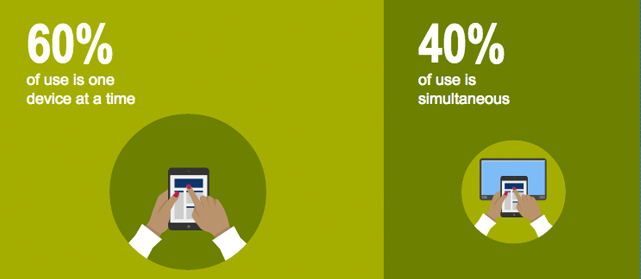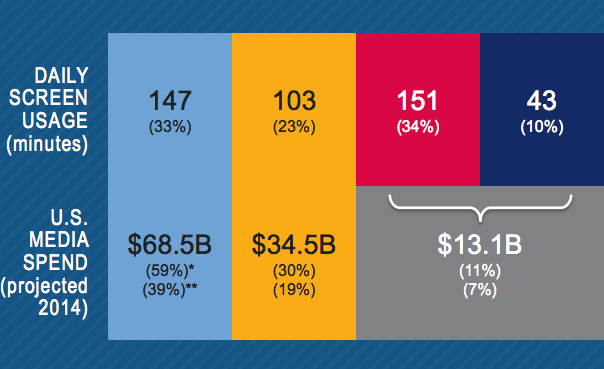Mobile now leads TV in screen usage time, a new study released by communications market research firm Millward Brown has found with an average of 132 minutes per day compared to 125 for television.

The study, which canvassed over 12,000 screen users from across 30 countries – including Australia – provides a number of insights about the way people are using their devices. It found that 40% of the usage that occurs in Australia happens with users accessing multiple devices simultaneously.

The smartphone edged out the TV for most popular screen by just seven minutes. However if taken together, internet enabled devices far outweigh television with more than twice the amount of time being used daily.
What’s really interesting is when we cross-reference this screen use with exactly when each device is being used. From the series of graphs below, the strength of smartphones and laptops are clear – remaining consistent throughout the day. Even when television enjoys a surge of use in the evening, mobile remains a competitive alternative.

Millward Brown discuss the concepts of ‘meshing’ (using devices in an integrated or related way – say, tweeting about a TV show you’re watching) and ‘stacking’ (using the devices for separate purposes – like flicking to Facebook to see what’s happening if the show is boring). They say 71 per cent of Australian multiscreen use is stacking – with filling time during advertisement breaks, keeping up with social media and having the TV as background noise primary reasons for stacking.
This has implications for your marketing approach, particularly given the concept of multi-channel funnels. This relates to the way customers find your products or services, learn about them and then make a purchase or take another action. The idea of multi-channel funnels is that customers are moving from channel to channel – say from television, to mobile, to personal computer – and each of these channels plays a role in bringing them further down the sales funnel.
What this study shows is that channels aren’t just being used, but are being used simultaneously – which could indicate ripe opportunity to leverage a multi-channel funnel strategy. This might take the form of showcasing your product on a mobile app, then pushing leads to a tablet and finally to a PC for conversion. Given the devices are being used together by Australians – as this study shows – bringing them down the funnel may be simple.
But while we can now say for certain that mobile has a huge usage base, advertising spend is not following what the market is watching. Though Australian figures for this particular part of the study aren’t available, US data indicates that $13.1 billion will be spent on mobile advertising over 2014. $68.5 billion will be spent on TV. This massive disparity comes despite the fact that the daily screen usage between the two channels is almost on par (151 minutes to 147 minutes per day).

Millward Brown says ad spend in mobile is set to rapidly increase in coming years – and should potentially grow even faster than forecasts suggest.


